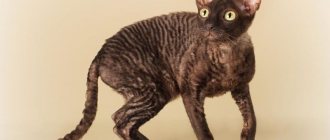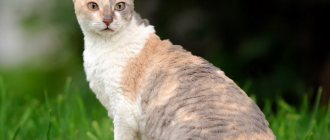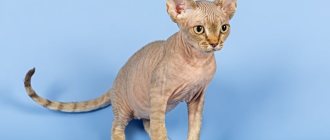One of the rare breeds of cats is the Ural Rex. These are native kittens with curly hair. Moreover, the breed is natural and was not bred artificially. And although it belongs specifically to the Rex breed, the hair of such individuals curls a little differently.
Brief history of the breed
The homeland of Russian rexes is the Urals. Despite the fact that the first mentions of similar animals date back to the 40s of the last century, the ancestor of the Uralians is considered to be the black bicolor Vaska, who was born in 1988 and lived in the city of Zarechny, Sverdlovsk region.
For the first time, Russian rexes were demonstrated at the St. Petersburg cat exhibition in 1992. A couple of years later, a preliminary breed standard appeared. And in 2006, the Ural Rex received recognition from the international WCF system.
Owner reviews
This breed is not yet very common, but in the Urals it can be found everywhere. Fortunately, it began to appear more and more often in other regions of Russia. Let's read reviews about the Ural Rex and find out what real owners say about them:
- Olga first met funny curly-haired cats at an exhibition, and from the very first minute she realized that she wanted to get one for herself. After the overly active Abyssinian, the Uralian seemed to her like a quiet angel. She notes that her pet’s character is incredibly loyal, affectionate, unobtrusive and not at all harmful.
- Elena has as many as 6 representatives of this breed, and despite this, she considers them the best animals. They always surround her with their care, attention and affection.
You can always add your comments to the owners’ reviews; we will be very interested to read about your impressions and friendship with such a curly-haired miracle.
Ural Rex with red coat color
Handsome black man with white paws and collar
Interesting Facts
Despite the youth of the Urals, interesting facts have already appeared about the breed:
- To improve the Ural cats, breeders bred them with Bohemian and Cornish Rex. But as a result, the kittens had straight hair. Thanks to these experiments, it became clear that these breeds have different “curl genes.”
- The waviness in the coat of the Ural Rex appears earlier than in other curly-haired cats. Curls become noticeable by 3-4 months. And by the age of six months, Ural residents develop curly waves.
Color
You can find various photos of the Ural Rex cat with any combination of colors. But there are recognized standards that stipulate the following rules:
- The uniform coat color of this breed is available in white, red, blue, cream, black, gold and silver;
- Any combination with white is allowed, mainly bicolor, tortie with blue or black, tortoiseshell, van, tabby or harlequin.
However, there are a number of restrictions, for example, it is unacceptable for the Ural to have a chocolate shade, cinnamon color, ticking or Burmese color.
Ural rex black
Breed description, standards, appearance
The Ural Rex is a proportional, harmoniously built cat with a minimal layer of fat and well-developed muscles. An experimental breed standard was written in 1994. The last time the document was sent for revision was in 2012.
Dimensions and weight
Representatives of the breed are not large. An adult Ural cat weighs no more than 4 kg. The cat's weight is about 6 kg.
Anatomical characteristics
A typical Ural Rex should fit the following description:
- The head is in the shape of a wide wedge, with pronounced cheekbones, a developed chin, a slightly rounded forehead and a flat bridge of the nose.
- The ears are small to medium in size and resemble an isosceles triangle. They have a wide base, rounded tips, straight and high stance.
- The eyes are oval, slightly slanted. The iris is painted in any color that is in harmony with the tone of the Ural fur.
- The body is slender, compact, with developed muscles and a rounded chest.
- The limbs are muscular, with oval paws and strong claws.
- The tail is of normal length, with a slightly rounded tip.
Color and coat type
The body of the Ural rex is covered with thick, silky and soft hair, forming waves and elastic curls. Some cats of this breed have a small mane.
The coat color can be any color with the exception of chocolate, cinnamon, Burmese and Abyssinian ticking. Most often, Ural cats have blue, cream, tortoiseshell, black, silver, white and gold colors. Also common in the breed are color options such as harlequin, van, tabby and bicolor.
On a note. The fur of Ural Rex kittens may have a grayish tint, which disappears after the first molt. The black or black tabby color may acquire a brown and bright golden tone after 2 years.
Possible breed defects
Flaws in appearance, in the presence of which the Ural Rex will not receive a high expert assessment:
- ears that are too small or large;
- straight wool;
- long and thin or short thick body;
- wide base of the tail;
- short limbs;
- polydactyly;
- tail defects;
- malocclusion;
- deformation of the skull bones.
Read more about cat breeds with curls.
Health
Testing by inbreeding (breeding) has proven that rexes do not suffer from genetic and hereditary diseases, have an excellent immune system, and are well resistant to any diseases. However, vaccination is never superfluous. Kittens are vaccinated for the first time at 4 months of age; the subsequent vaccination schedule is drawn up by the attending veterinarian, who also indicates when preventive treatment for worms, fleas and ticks is necessary.
Normal body temperature is 38 °C; an increase or decrease may indicate the presence of pathologies. The most common problems are with the intestines and bladder. To prevent diseases, it is enough to visit a doctor 1-2 times a year and strictly follow all recommendations. Then a healthy and happy Rex will delight you for a long time - 14-15 years.
Character and temperament
Ural cats are affectionate, sociable and friendly cats. They quickly become attached to their owners and love to spend time in the company of people. Ural rexes like to sit in their arms and sleep on their owner's bed. They should not be deprived of attention and left alone for a long time.
Due to their playful and good-natured nature, Ural residents easily find a common language with children of different ages and will not let them get bored. Cats of this breed never show aggression and are patient with childish pranks.
Friendly and non-conflicting, Ural Rexes get along without problems with other pets, including good-natured dogs.
Breeding the Ural Rex
If you want your beloved cat to give birth, you need to remember that the Ural Rex cannot be mixed with cats of other breeds.
Puberty in cats of this breed occurs at approximately 8–9 months. But it is not recommended to bring together both a cat and a male cat at such a young age, since the animal’s body is not yet ready to function as an adult. The optimal time for the first mating is about one and a half years old.
Estrus usually occurs calmly in female cats, without the heart-rending screams that often accompany this process in other cats.
The pregnancy of the Ural Rex proceeds without any special features. One litter usually contains from 2 to 4 kittens.
How to choose the right kitten
Ural rexes are a fairly rare breed of cat, but with the right approach, purchasing such a pet usually does not pose any problems. It is better to purchase a purebred animal from a certified nursery or from a trusted breeder. At the time of the transaction, the kitten must have a veterinary passport with vaccination marks and a document confirming its origin.
You should also pay attention to the appearance of the small Ural. It must have all the characteristics characteristic of representatives of the breed. A healthy kitten should have clean ears, clear eyes, smooth skin and a soft belly.
Kitten care
For up to 3 months, little Ural cats live with their mother and before moving to a new home they have time to learn to eat many foods, master hygiene skills and get used to the tray. Therefore, most owners usually do not have problems with curly pets.
The new owners of a Ural kitten can only wait until the baby gets used to the changed conditions and show him where he can eat, rest and relieve himself.
To prevent accidents, all wires, ornamental plants, chemicals, small and fragile objects are removed from the pet. Also, to ensure safety, small Ural residents are denied access to large household appliances and open windows.
To prevent digestive problems against the background of stress from a change of place of residence, at first a kitten of this breed is fed only the usual food. New products are introduced into the menu of a Ural resident gradually in order to observe the reaction of his body.
The feeding schedule is based on the age of the animal:
- up to 12 weeks – 5-6 times a day;
- 3-7 months – 4 times a day;
- 7-12 months – 3 times a day.
A one-year-old Ural Rex is fed twice a day.
Castration and sterilization
Ordinary people often use the terms castration and sterilization in relation to the sex of an animal. We are accustomed to thinking that only males are castrated, and cats are sterilized. However, you need to know that using these concepts in this sense is incorrect. In medical practice, these two operations are not gender specific:
- castration is the removal of reproductive organs in animals: in males the testicles are removed, and in females castration can be partial - only the ovaries are removed or complete - the ovaries are removed along with the uterus;
- Sterilization is an operation that removes reproductive organs from female animals and removes testes from male animals.
There is no consensus regarding the best age for these operations. It is believed that the optimal time for the cessation of reproductive functions is the age of 7–8 months, that is, before the animal becomes sexually mature. Some veterinarians believe that it is better to perform these operations at an even earlier age.
It is better to carry out the operation before the animal reaches sexual maturity.
Care and maintenance
Ural rexes do not need special conditions, but they love comfort. Therefore, they must be provided with a cozy place to sleep and relax. Otherwise, caring for cats of this breed comes down to hygiene procedures and balanced feeding.
- The ears and eyes of the Ural Rex are systematically wiped with moistened wipes and inspected for the presence of unusual discharge.
- As they grow, the cat's claws are shortened with a nail clipper, removing only the transparent part and trying not to touch living tissue.
- The Ural Rex's teeth are cleaned 2-3 times a month with a silicone brush with a small amount of non-foaming paste.
- The dead hairs of a cat of this breed get stuck in the curls and cannot fall out on their own. To prevent the Ural Rex from clogging the gastrointestinal tract when licking its fur, it is combed out with a special brush. In normal times, this is done once a week, during the molting period - every other day.
- Urals have very delicate skin, which can be easily dried out by detergents. Therefore, representatives of the breed are bathed only in extreme cases.
On a note. After bathing procedures, the fur of curly cats becomes dull and too “fluffy”. Therefore, it is recommended to wash show Ural Rex cats 2 weeks before the event so that their coat has time to regain its normal appearance.
Purchasing a kitten
Buying a Ural Rex kitten in Russia is quite simple. But, like other representatives of rex breeds, Uralians are relatively expensive. The exact cost of a kitten depends on the age, gender, appearance and class of the animal. A kitten for the “soul” (pet class) will cost over 15,000 rubles. A cat for future breeding (breeding class) will cost up to 50 thousand rubles, and for a future champion and title holder you will have to pay more than 50 thousand rubles.
To buy a good Ural kitten, you need to contact only specialized nurseries. The best cattery is an organization that breeds only one breed (even if the entire cattery consists of just one cat). If cats of several breeds are bred in one place, then most likely the goal of these people is to sell kittens that are similar to purebred ones.
The price of a kitten depends on several criteria: class, age, gender
How to choose a good kitten
When choosing a kitten in a nursery, you need to be guided by several criteria:
- appearance (the animal must be neat and well-groomed, without visible wounds, scratches, discharge from the eyes or nose);
- absence of skin parasites (you can part the fur with your fingers; there should be no fleas or their excrement on the skin and fur);
- the kitten’s behavior (the baby should be cheerful, moderately active and friendly);
- availability of documents (the animal must have a veterinary passport indicating all vaccinations: against calcivirosis, panleukemia, etc., as well as a pedigree);
- breed characteristics.
It is believed that all little kittens are alike, but you must be sure that you choose a real Rex. Even the smallest Uralian should show signs of the breed . These kittens are born already curly, however, the curly hair forms into even waves by six months. At the same time, the guard hairs remain soft to the touch (as if thinned). The fur of kittens has a grayish, gray tint. Later, the rex's fur will oxidize and take on a golden hue (especially in black and red rexes).
The Rex kitten has a well-defined cranial part of the head, the eyes are bulging and widely set, and the nose is wide. The kitten's muzzle is an inverted triangle; the high cheekbones are especially visible. Otherwise, the body of the little Uralian differs little from the constitution of representatives of other breeds.
Video: little Ural kittens
Suitable age to purchase
Many people want to adopt a very young kitten, but few dare to tear the baby away from the mother cat. Next to its mother, the kitten feels protected. The cat feeds it, and with colostrum the kitten receives primary immunity. A baby who is separated from a cat too early may be mentally vulnerable, ill, and have behavioral problems. Such animals can damage furniture, walk past the litter box, and generally disobey their owner.
The kitten tries to imitate its mother in everything, which is why it is so important to let the kitten learn all the skills from the cat. This is necessary so that the animal begins to eat properly, go to the litter box, and communicate with its relatives. Only by two months does the kitten begin to sense moderation in play, controlling the force of its bites and not scratching its comrades.
At about 2 months, the primary immunity received by the kitten from its mother begins to decline. At this time, they begin to prepare the baby for the first vaccination. Kittens are not vaccinated until they are 3 months old, and if they are brought into a new home without immunity, the baby runs the risk of getting sick. In unusual conditions, the animal’s body can be attacked by viruses and infections. There was a case in my family when we had to take in a very small kitten who was left without a mother. He fell ill, suddenly began to feel unwell and took ill. Of course, we immediately called the vet, but the cat died anyway. The veterinarian said the cause of death was distemper.
You cannot separate a kitten from its mother until it is 3 months old.
Feeding the cat
Urals are unpretentious in food, so you can feed them both industrial and natural food. The main thing is not to mix these types of nutrition with each other.
When feeding dry food, Uralians buy premium or super-premium products from trusted manufacturers. It is important to ensure that it does not contain any dubious additives such as soy, dyes and preservatives.
The following brands of food are best suited for residents of the Urals:
- Bosch;
- Hills;
- Pronature;
- Gemon.
With a natural type of food, a cat's diet should consist of 70-80% meat. The Ural resident is also given:
- boiled vegetables;
- porridge with water;
- offal;
- boiled eggs;
- dairy products;
- oceanic or sea fish of low-fat varieties.
Bread, sausages, sweets, mushrooms and smoked meats are excluded from the Ural Rex’s diet. Also, a cat of this breed is not given pork, beans, exotic fruits, or any leftovers from the owner’s table.
Combing
It is important to spend some time grooming your pet.
There are reviews that if you regularly stroke its fur with a piece of suede, then the animal’s hairs will shine, and the curly curls will retain their original shape.
If you wish, you can buy a special comb that has rounded ends and use it.
Pay attention to when your Ural Rex cat first begins to shed.
Then carry out trimming: carefully pluck all the gray hairs from the kitten’s fur.
This procedure should be carried out in the future.
It helps the cat get rid of excess hair, since rexes themselves do not cope well with this.
Due to their active lifestyle, Ural kittens often get dirty.
In this case, the owners of curly-haired pranksters are faced with the question of what to do if frequent washing of such animals is contraindicated.
You can learn how to properly wash a cat from the article
Then you can simply use a special dry shampoo, which is applied to the coat and then removed with a cloth.
Important! Before purchasing new care products for your pet, consult your veterinarian. He will tell you what is worth using and what is better not to use at all. The nursery where the four-legged friend was purchased can also give recommendations on keeping rexes.
It is not recommended to bathe these cats several hours before the exhibition, since their curly hair will not have time to dry before the start of the event.
Education and physical activity
Urals are cats with fairly high intelligence. They try in every possible way to please their owners and easily learn the rules of behavior in the house. Curly-haired cats quickly get used to the litter box and are able to perform simple tricks.
The Urals are very fond of all kinds of toys and can play with them for hours. To maintain good physical shape, cats of this breed are provided with a special corner with numerous ladders and multi-level platforms.
Rules for caring for a Cornish Rex
The Cornish coat requires attention. When combing, in order not to spoil the hairs and preserve the characteristic curls, you should use only brushes made of natural bristles. Do not use combs or massage brushes with metal teeth: they can damage the delicate skin of the animal. These cats should be brushed no more than 2 times a week.
Cornish Rexes are bathed as they become dirty. It is not recommended to wash the animal more often than once every 3-4 months. For bathing, you need to use shampoos that are designed for washing cats of short-haired breeds. For example, Ms. Kiss No. 1 or BioVax. A cat of this breed should only be lathered in the direction of hair growth. After washing, the Cornish's fur must be blotted with a soft towel. In this case, you cannot rub them. Blow drying is not recommended.
Caring for the eyes of Cornish cats is quite simple and does not differ much from caring for the eyes of other purrs. They should be cleaned of secretions as they become dirty, about once a week. To do this, you can use a cotton pad moistened with boiled water.
Rexes have very large ears, and large amounts of wax and dirt can accumulate in them. Therefore, it is recommended to clean them at least once a week with a dampened cotton swab.
But you just need to do this very carefully so as not to damage the eardrum and hurt your pet.
Nail trimming is optional for this breed. But to prevent the cat from accidentally scratching others, you need to do this procedure at least once a month.
To prevent the appearance of an unpleasant odor from the mouth, you need to clean your pet’s teeth several times a month (on average every 7-10 days) with special toothbrushes for animals or regular small brushes for children.
Video: how to bathe a Cornish Rex
Cornish Rex can go to the toilet in absolutely any container. The main thing is that it is the right size for your pet. The filler doesn't matter either. These animals are not picky at all.
Nutrition
Adult Cornish cats need to be fed 2 times a day. Kittens up to 3 months are fed 5 times a day. Once they reach six months of age, the frequency of feedings is reduced to 3-4 times a day. And at the age of 10–12 months, kittens eat 2–3 times a day.
You can feed cats either ready-made premium or super-premium food (dry, wet or canned), or natural products.
Ready-made feed
Among the manufacturers of ready-made feeds are:
- ACANA;
- PRO PLAN;
- BOSH;
- ROYAL CANIN;
- HILLS;
- EUKANUBA;
- EAGLE PACK;
- IAMS;
- NUTRO CHOICE;
- PRO NATURE;
- INNOVA;
- CHICKEN SOUP;
- ORIGIN.
It is not recommended to feed cats of this breed with economy-class food, as this can lead to serious health problems.
Natural products
When deciding to feed your pet natural food, you need to remember that its diet must include such products as:
- boiled lean meat (beef, turkey, chicken), liver, heart;
- dairy products;
- unsalted cheeses;
- raw or boiled vegetables;
- egg yolk;
- cereals (oatmeal, rice, buckwheat).
The following products should absolutely not be included in the Cornish diet:
- bones;
- fat meat;
- fatty, spicy, salty, smoked foods, including sausages and canned food for people;
- sugar, chocolate, sweets, cakes and everything sweet;
- potato;
- legumes (soybeans, peas, beans);
- salt, spices.
Pros and cons of the breed
Urals, like any other cats, have both advantages and disadvantages.
| pros | Minuses |
| Original appearance | Rarity of the breed |
| Amenable disposition | High cost of kittens |
| Good health | Intolerance of loneliness |
Ural rexes are rare cats with a non-standard, but very attractive exterior and easy-going character. They easily find a common language with all household members and quickly turn into real family members.
Peculiarities
This cat has a number of points that most fully characterize this breed:
- Curly nature of the coat. The density of the curls is determined by the length of the coat.
- Cats have proven themselves to have wonderful personalities.
- The breed is characterized by excellent health.
- At birth, kittens have a gray tint, which disappears without a trace after the first moult.
- If the cat is black, then when it reaches the age of two years, a change in color occurs. A characteristic golden hue appears.
- Cat fur does not cause allergies. For this reason, the breed is suitable even for those who are prone to allergic reactions.
Scottish Fold cat - description of the breed











